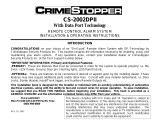
19
RF Tamper Re-Arm:
Note
: This feature is activated automatically when the alarm is programmed for automatic arming.
See “Remote Feature Programming” for details. (Page 14, 15)
1. Alarm must be programmed for automatic arming.
2. Close all protected entrances and arm the alarm with the remote transmitter. The LED will be
flashing at a normal rate.
3. Wait 5 seconds and disarm the alarm using the remote transmitter. The LED will begin to flash
fast. (Automatic arming indicator)
4. Wait 60 seconds and the alarm will become rearmed. (Re-arm will be silent)
5. Repeat steps 1 through 4. When the LED starts flashing fast, open one of the protected
entrances (door) the LED will turn off. Close the entrance and the LED will begin to flash fast
and the timer will begin counting again.
Note: After the door has been closed, the timer duration is reduced to 30 seconds.
60 Second Re-Arm Timer and Re-Lock Function:
Once the alarm is triggered, the siren will sound for 60 seconds and then stop. The alarm will
remain in an armed condition. If the door locks have been installed into the system, they will re-
lock when the alarm resets after 60 seconds.
Channel #2 Output: (If Installed)
1. Depress the Aux. button for 3 sec. when using dedicated buttons mode.
2. Depress the Unlock button for 3 sec. if programmed for separate Channel Mode.
Channel #3 Output: (If Installed, Available on M5 Only)
1. Depress the Lock & Aux button at the same time when using dedicated button Mode.
2. Depress the Aux buttons if programmed for separate channels mode. The alarm will emit a
ground signal on the Blue/White channel #3 wire for as long as channel #3 is activated.
Dual Zone Sensor Pre-Warning Indicator: (Dual zone sensor must be installed)
1. Close all protected entrances and place the alarm in an armed condition.
2. Rap the vehicles body panels to activate the pre-warning zone of any dual zone type sensor.
3. When the pre-warning indicator is triggered, the horn/siren will emit 1 long beep/chirp.
Carjacking Feature: (If installed, this feature must be programmed on)
1. Enter the vehicle and close all the entrances. (If the vehicle has dome light delay, wait for the
dome light to go out before beginning the test)
2. Set the ignition key to the on position. Wait 5 seconds and open the driver’s door then close it.
3.
Within 50 seconds the horn/siren will begin to beep (Short Pulses). This is pre-warning that the
carjacking alarm will become fully triggered within 10 seconds.
Note: At this point, the carjacking alarm can be disabled by setting the valet switch to the on position.
4. Within 10 seconds, the carjacking alarm will be fully triggered. The horn/siren will sound
normally, the parking lights will begin flashing and the starter disable will be engaged.
5. Turn the ignition key off, then back on.
6. Set the valet switch to the on position and the horn/siren will stop sounding and the parking
lights will stop flashing.
WARNING! When the carjacking alarm is programmed on, every time the ignition key is on and a
door gets opened, the 50 second timer will begin counting. If a door is open (dome light is on)
before the ignition key is turned on, the 50 second timer will not start counting until the door is
closed and re-opened.
Step 9:
Speciality Feature and Optional Equipment Testing


























